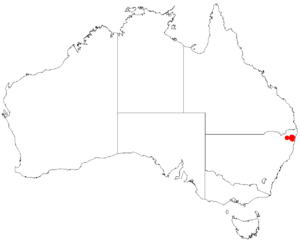Prostanthera sejuncta facts for kids
Quick facts for kids Prostanthera sejuncta |
|
|---|---|
| Scientific classification | |
| Genus: |
Prostanthera
|
| Species: |
sejuncta
|
 |
|
| Occurrence data from AVH | |
| Synonyms | |
|
|
The Prostanthera sejuncta is a special flowering plant that belongs to the mint family, called Lamiaceae. It's found only in a small area of New South Wales, Australia. This plant is a sprawling, low-growing shrub that smells nice and has spiky branches. It has narrow, egg-shaped leaves and pretty flowers that can be pale purple, light lilac, or almost white.
Contents
What Does This Plant Look Like?
The Prostanthera sejuncta is a shrub that grows low to the ground, often spreading out. It usually reaches about 50 centimeters (about 20 inches) tall. Its branches have sharp spines that can be up to 16 millimeters (about half an inch) long. These spines grow in pairs, opposite each other, sticking out at right angles.
Leaves and Glands
The leaves are light to dark green, with the underside being a bit paler. They are narrow and shaped like an egg, measuring about 1.5 to 6 millimeters long and 1 to 4 millimeters wide. They grow on a small stalk called a petiole, which is about 0.4 to 1 millimeter long. The leaves also have tiny glands on their lower surface that are almost directly attached.
Flowers and Petals
The flowers grow where the leaves meet the stem, which are called leaf axils. At the base of each flower, there are small leaf-like parts called bracteoles, about 0.9 to 2.5 millimeters long. The sepals, which are the green parts that protect the flower bud, are about 3.5 to 6.5 millimeters long. They join at the bottom to form a tube about 2 to 3 millimeters long. This tube has two parts, or lobes, with the upper one being about 1.5 to 3 millimeters long. The colorful petals of the flower are about 8 to 14 millimeters long. They can be pale mauve (light purple), pale lilac, or almost white.
How Was This Plant Named?
The Prostanthera sejuncta was officially described and named in 2006. This was done by three botanists: Mark Williams, Andrew Drinnan, and Neville Walsh. They published their findings in a science journal called Australian Systematic Botany. The plant specimens they studied were collected from a place called Mount Arapiles. Before 2006, these plants were sometimes confused with another similar plant, P. spinosa, which is found only in Victoria.
Where Does This Plant Live?
This type of mintbush grows in rocky soil. You can find it near a town called Copmanhurst in the north-eastern part of New South Wales. It's quite rare and only grows in this specific area.
Is This Plant Safe?
The Prostanthera sejuncta is considered "vulnerable." This means it's at risk of disappearing if we don't protect it. It is mainly found in Fortis Creek National Park and a nearby nature reserve. The New South Wales Government lists it as vulnerable under their Biodiversity Conservation Act 2016.
What Threatens This Plant?
There are a few things that put this plant at risk:
- Clearing land: When land is cleared for buildings or farms, the plant's habitat is destroyed.
- Road and track work: Maintenance of roads and tracks can disturb the areas where the plant grows.
- Fires: The wrong kind of fires, either too often or not often enough, can harm the plant.
- Small living area: Because it only grows in a very small area, it's more sensitive to these threats.

